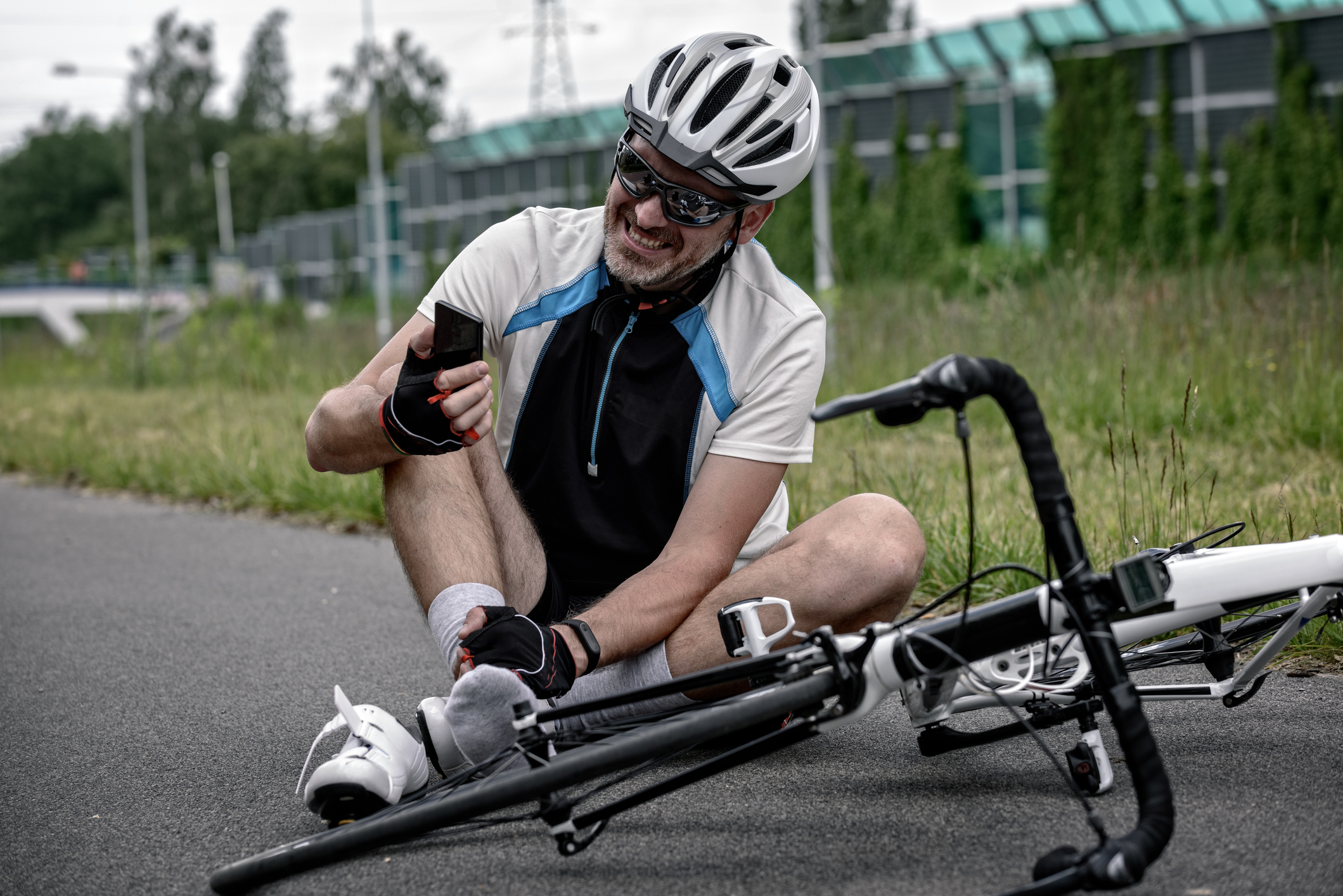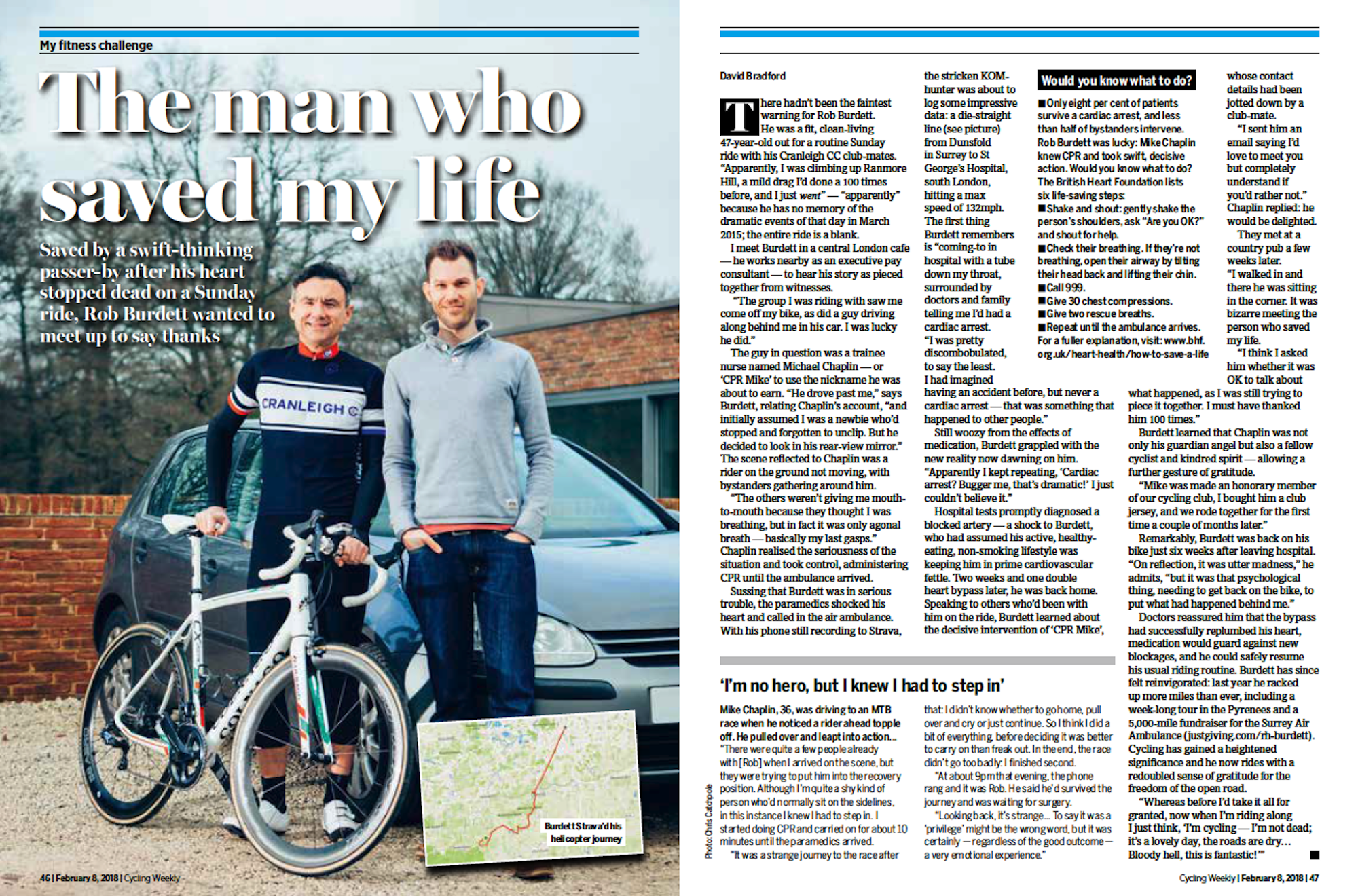First aid for cyclists: Would you know what to do in an accident?
It’s every cyclist’s nightmare: someone in your group has crashed and it looks serious. How do you provide urgent, potentially life-saving assistance?


Would you know what to do if you were out riding and a ride mate crashed heavily or suddenly fell ill? It’s a scenario we all hope we’ll never confront, but cycling involves speed, open roads and hazards, and puts strain on the body’s cardiovascular system, so it will never be without danger. Even so, a little preparation can make a big difference.
Danish footballer Christian Eriksen’s cardiac arrest while playing in the Euro 2020 tournament this summer was a stark reminder of how a first responder’s actions can be the difference between life and death. It’s arguably even more important among us cyclists, as we’re often in remote locations miles away from professional emergency help.
In this feature, we have collated advice from experts across various emergency-medicine fields to give you straightforward tips on how to respond swiftly and effectively to emergencies ranging from nasty-looking road rash, to concussion, to cardiac arrest. The better equipped we all are to deal with these situations, the more chance we all have of happier outcomes.
Making the scene safe
The first thing to do in an emergency situation is to assess the scene and determine if it is a safe place to perform first-response skills. Watch out for any hazards such as traffic, steep drops or water, before assessing the affected person’s signs and symptoms. If possible, gather information on their medical history – do they suffer from asthma or have an allergy or any other underlying conditions?
First aid for cardiac arrest
Any cyclist who has a heart condition, be it an abnormal heart rhythm or a history of cardiac problems, is strongly advised to seek “individualised guidance from a specialist or a GP as to what they can and can’t do,” urges Joanne Whitmore, senior cardiac nurse at the British Heart Foundation. No matter a person’s physical fitness, anyone can suffer a cardiac arrest – literally, the heart stopping as the result of an electrical fault. This is to be distinguished from a heart attack, when a blockage in a cardiac artery impedes the flow of blood to the heart, which leads to chest pain and can progress to a cardiac arrest.
SPOT THE SIGNS Heart attack can be indicated by the onset of chest pain that may radiate to the neck, shoulders, arms and even the teeth; the feeling of heaviness; pain that feels like indigestion; shortness of breath; sweating; pale, cold and clammy skin; feeling sick.
WHAT TO DO The responder should follow the ABC guidelines, first checking the airways, then for breathing, then for circulation, calling 999 asap. If the person is not breathing or has no pulse, you should start chest compressions. Whitmore advises: “Don’t worry about potentially breaking a few ribs – if you do nothing, they may die. The emphasis is on chest compressions and delivering rescue breaths if you feel comfortable in doing so.”
Get The Leadout Newsletter
The latest race content, interviews, features, reviews and expert buying guides, direct to your inbox!
GOLDEN RULE “The most important thing anyone can do is call 999 straight away,” says Whitmore. “If you suspect a cardiac arrest, don’t wait.”
First aid for breathing problems
Breathing issues limit performance and can be worrisome. “A lot of elite athletes have asthma, so having breathing issues doesn’t have to take away the enjoyment of the sport,” says James Hull, a consultant respiratory physician at the Institute of Sport, Exercise and Health. However, episodes can be acute and result in the need for urgent medical help.
SPOT THE SIGNS “If you hear loud wheezing, noise from the upper part of the airways, a tightening throat or tickle in a throat, you need to consider medical assistance,” says Hull. The person’s skin may also appear pale, and they may lean forward, indicating an imminent collapse.”
WHAT TO DO Sit them in a safe location and loosen tight clothing. Find out if they have asthma, allergies and if they take any medication. Help the person use their inhaler if required.
GOLDEN RULE While waiting for emergency support, keep them warm and try to calm them down because, as Hull advises, “if they hyperventilate or have a panic attack, it can make the situation worse.”
First aid for an allergic reaction
Act fast if someone isn't breathing...
If the person appears not to be breathing, enact this ABC protocol:
Airway: Check the person’s airway to ensure it is not obstructed. If you suspect it may be blocked, open their airway by placing one hand on their forehead, move their head back slightly and use two fingers from your other hand to raise their chin slowly.
Breathing: To establish if a person is breathing, put your ear directly over their mouth and look down their body. Check for the feeling of their breath on your cheek and if their chest is rising and falling. Do this for 10 seconds. If they are not breathing, give rescue breaths (see below).
Circulation: Check their pulse with your index and middle fingers on their wrist, just below the thumb. Count how many beats there are in a minute. If you cannot feel a pulse, apply chest compressions to restore blood circulation in the body (see below). CPR is required when the person is not breathing or only gasping from time to time. Do 30 chest compressions followed by two rescue breaths. To do this, lay the person on their back, and with the heel of one of your hands and with a straight elbow, push hard and fast in the chest’s centre, just below the nipples. Allow the chest to fully rise between compressions. When delivering rescue breaths, place your mouth fully over theirs and blow hard to make their chest rise.
For a fuller explanation, visit: www.bhf.org.uk/heart-health/ how-to-save-a-life
An estimated one in four people in the UK will have an allergic reaction at some point in their life, and though most are non-severe, such as hay fever, an adverse reaction to food or bee stings can be life-threatening.
SPOT THE SIGNS The most common primary symptoms are a red, itchy rash, and red, itchy eyes, as well as swelling of the hands, feet or face. Breathing difficulties, diarrhoea, vomiting or abdominal pain may follow. Sneezing and coughing may be present, too.
WHAT TO DO In mild cases, antihistamines and decongestants can be used in the short term, but in a severe event, call 999 immediately and explain the affected person is suffering suspected anaphylactic shock. If the severely affected person is carrying an EpiPen, the first-aider should inject them every five minutes if there is no improvement. First-aid training covers correct usage of an EpiPen, and in a life-threatening emergency it should be administered.
GOLDEN RULE If the person is experiencing anaphylactic shock, lay them flat on their back. Do not allow them to stand or walk. If they’re vomiting or bleeding, lay them on their side.
First aid for a head injury
A heavy blow to the head can harm the brain and/or fracture the skull. Though most knocks to the head do not cause lasting damage, it is important to be aware of signs of concussion. “Even if the person seems just mildly confused, they should not cycle home,” says paramedic Richard Webber. “They risk coordination problems and having an even worse accident. Someone should keep a regular eye on the person for the next 24 hours.”
SPOT THE SIGNS A lack of responsiveness, dizziness and confusion all point to concussion, as does memory loss of the event and a headache. The person may also have trouble speaking, and unequal pupil sizes.
WHAT TO DO If the person is not responding, call 999 and monitor their ABCs. If they are responsive, sit them down. Then follow the AVPU acronym for signs of concussion checks: Alertness, followed by Verbal, Pain and Unresponsiveness.
GOLDEN RULE In the case of a severe head blow that has knocked the person unconscious, do not move them, as they may also have an unstable spinal injury.

How to treat road rash
A crash can leave us without serious injuries, just bloodied and bruised, with the top layer of skin scrubbed raw through friction with the ground.
SPOT THE SIGNS An abrasion on the skin and a reddening of the area, with small cuts and oozing fluid. The whole area may be bruised and inflamed.
'I'm alive thanks to a first responder'

“Without Mike administering correct CPR for 10 minutes before the paramedics arrived, I wouldn’t be talking to you now,” says Rob Burdett.
In March 2015, Burdett, just 47 at the time, was out on a Sunday club run with Cranleigh CC when he suffered a cardiac arrest. His clubmates tried to help, but it was the intervention of a passing driver, Michael Chaplin, who helped bring him back to life.
“Despite their efforts, nothing my clubmates were doing was making a difference,” Burdett tells CW. “They thought I was breathing but Mike knew it was just dying gasps. He bravely took control of the situation because he knew I was having a cardiac arrest and knew what to do.”
Burdett made a full recovery from his near-death experience, and has since gone on first-aid courses himself and given money to Millie’s Trust (milliestrust.com), an organisation that tours the country delivering first- response skills. “Hopefully if I encounter someone in distress I may know what to do,” says Burdett. “The more we all do that, the better. Knowing your intervention can have an enormous impact on someone’s future is amazing. I’m so glad I now have some of those skills.”
WHAT TO DO Neil Studd of St John Ambulance says: “Providing there are no serious injuries, the first thing to do is clean the wound with soap and water or a sterile wipe. Cover the wound with a sterile dressing and once you get home give it a proper clean to remove any smaller specks of dirt and to prevent infection. Cover it again with a sterile non-stick dressing.” Road rash should be kept covered for the first 24 hours with a non-stick dressing – alginate types can help to keep the area moist and promote healing – held in place by gauze.
GOLDEN RULE Ensure the wound is clean to prevent infection. “If the wound is heavily contaminated with dirt or starts to show signs of infection, you should seek medical help,” adds Studd.

Thank you for reading 20 articles this month* Join now for unlimited access
Enjoy your first month for just £1 / $1 / €1
*Read 5 free articles per month without a subscription

Join now for unlimited access
Try first month for just £1 / $1 / €1
A freelance sports journalist and podcaster, you'll mostly find Chris's byline attached to news scoops, profile interviews and long reads across a variety of different publications. He has been writing regularly for Cycling Weekly since 2013. In 2024 he released a seven-part podcast documentary, Ghost in the Machine, about motor doping in cycling.
Previously a ski, hiking and cycling guide in the Canadian Rockies and Spanish Pyrenees, he almost certainly holds the record for the most number of interviews conducted from snowy mountains. He lives in Valencia, Spain.
-
 How do the pros train? Noemi Rüegg's 26 hour training week
How do the pros train? Noemi Rüegg's 26 hour training weekWinner of this year’s Tour Down Under, the EF Education-Oatly rider is a climber whose talent is taking her to the top
By Chris Marshall-Bell
-
 Save £42 on the same tyres that Mathieu Van de Poel won Paris-Roubaix on, this Easter weekend
Save £42 on the same tyres that Mathieu Van de Poel won Paris-Roubaix on, this Easter weekendDeals Its rare that Pirelli P-Zero Race TLR RS can be found on sale, and certainly not with a whopping 25% discount, grab a pair this weekend before they go...
By Matt Ischt-Barnard